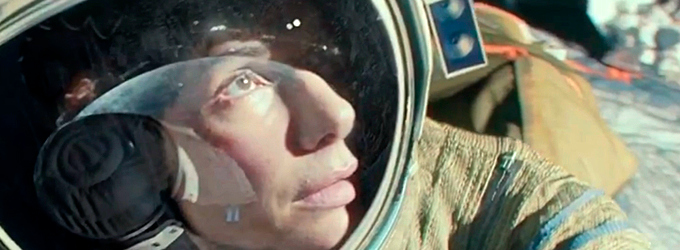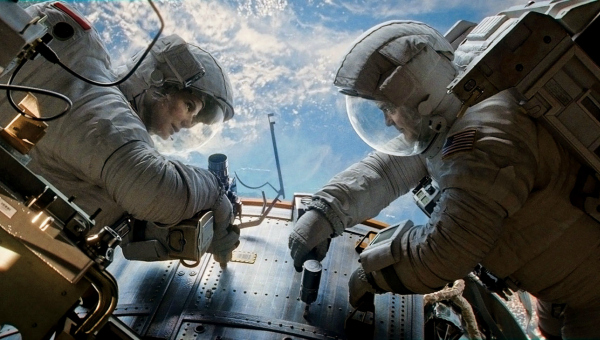 GRAVITY opens with one of the most masterly 13-minute continuous shots in cinema history. Four hundred miles above Earth, Ryan Stone (Sandra Bullock), is a NASA medical engineer on her virgin voyage into space. Her mission is to help repair the Hubble telescope. Tethered to a shuttle, she struggles with the equipment while veteran astronaut Matt Kowalsky (George Clooney) cheerfully circles her with his new toy, a jet pack that allows him to float in space without a tether. “You’re the genius out here,’ he tells her while listening to a country tune. “I just drive the bus.”
GRAVITY opens with one of the most masterly 13-minute continuous shots in cinema history. Four hundred miles above Earth, Ryan Stone (Sandra Bullock), is a NASA medical engineer on her virgin voyage into space. Her mission is to help repair the Hubble telescope. Tethered to a shuttle, she struggles with the equipment while veteran astronaut Matt Kowalsky (George Clooney) cheerfully circles her with his new toy, a jet pack that allows him to float in space without a tether. “You’re the genius out here,’ he tells her while listening to a country tune. “I just drive the bus.”
The camera is in constant motion from jaw-dropping wide shots to extreme close ups on Bullock’s tense face behind her helmet, with the blue Earth providing a stunning backdrop. Mexican-born director Alfonso Cuarón (CHILDREN OF MEN, HARRY POTTER AND THE PRISONER OF AZKABAN), his regular cinematographer Emmanuel Lubezki, and visual effects supervisor Tim Webber have collaborated to make us feel we’re floating above the Earth, no questions asked. Their opening shot brilliantly sets the stage for a 90-minute, gripping, edge-of-your-seats ride through outer space.
Inevitable comparisons with Kubrick’s 2001: A SPACE ODYSSEY have already circulated the blogosphere, but apart from being set in space, comparisons end there. This is not a stoned metaphysical journey through time and space in search of the meaning of life. Instead, Gravity is a scary amusement thrill ride set in real time. When Kowalsky transmits the message, “Houston, I have a bad feeling about this mission,” you better believe him. (The voice of Mission Control, in a nod to another space-disaster movie, Apollo 13, belongs to Ed Harris.) A few minutes later he receives the news that a Russian spy satellite has exploded and the debris is heading straight for them.
Cuarón is a true visionary, a master of pure cinema, and he roots every moment in a tactile present.
Suddenly the pair finds themselves spinning out of control, ricocheting around in a storm of debris, transformed into human pinballs. After a harrowing trip, including several minutes while Stone floats freely head over heels, they eventually make it back to the space station using Kowalsky’s dwindling power supply only to find the entire crew dead. A second wave of debris shatters the ISS in the film’s spectacular set piece of total destruction.
When Kowalsky sacrifices himself so that Stone will have a chance to survive, what began as a two-hander turns into a one-woman monologue. She is left alone to spend the rest of the movie talking to herself, trying to locate a deserted Chinese spaceship that contains a re-entry pod, which might get her home.
The real show here is a very fit and trim Bullock, giving her best career performance. For all its stunning exteriors, the film’s real concern is with her emotional makeup, letting her face and voice carry the burden of meaning. Some of the extended shots of Bullock’s face through her helmet visor have evoked comparisons to Maria Falconetti in Carl Dreyer’s classic THE PASSION OF JOAN OF ARC, the film that perfected the emotionally expressive close up.
Cuarón is a true visionary, a master of pure cinema, and he roots every moment of GRAVITY in a tactile present. It’s storytelling at its most simple – an ordinary woman set in extraordinary circumstances who has to summon all her will to survive – as its visuals are unbelievably complex. To achieve the photorealism the project demanded was to seamlessly combine live action, computer animation and CGI, and new systems had to be invented. One particular sequence, of Bullock gliding with weightless ease through narrow spaceship corridors is truly remarkable for its seeming effortlessness.
Canadian-born director James Cameron is one of people thanked at the end of GRAVITY, and this couldn’t be more appropriate. His groundbreaking AVATAR wrote the book on the modern artistic use of 3D. Ang Lee’s masterful LIFE OF PI wrote a new chapter last year, and this film is the next chapter – the most accomplished, wonder-inducing use of that technology to date.
httpvh://youtu.be/OiTiKOy59o4


How convincing, after the opening, is the pattern of destruction, though ? – we shouldn’t even be able to see Stone’s face, because she would have a silvered visor down because of the sun, or is it that the relative inertia of the opening, setting the scene, excuses all ?
As to seamless camerawork, I have heard that only the actors’ faces are not CGI, so there is, then, only a virtual camera. Bullock is very good for Bullock, maybe, but still…